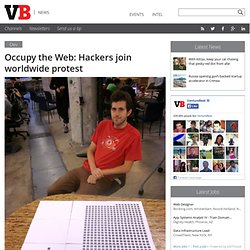

Hacking for the 99% OWS Hackathons Want to Build a Better Protest. Occupy Wall Street has an IT department.

The movement's technologists, like their park-squatting counterparts, are a decentralized group. But they've independently started hackathons this weekend in New York City, San Francisco and Washington, D.C. Even before the first protester showed up at Wall Street on Sept. 17, a group of people had started working on the movement's technology components. The so-called Internet working group has held meetings that covered how to edit the site openly, how to run the Twitter account and what server space to use. It's not necessarily the most organized operation, but it's becoming more so. "I think we're going to see a few people leading the helm really soon and saying this is what we need, this is what we're working on right now," says Occupy Together NYC Hackathon creator Andrew Gwozdziewycz, who is a casual member of several listervs that discuss the movement's technology needs.
Occupy Wall Street Hackathons Produce Digital Tools and New Activists. Groups of programmers gathered in three cities this weekend to build digital tools for the Occupy Wall Street movement.

Several of those tools have already launched, and in many cases they're being maintained by activists who've never held a sign in a park. "I was waiting to see how I should be involved," says Jake Levitas, who attended the San Francisco hackathon. "In the last week, I thought, 'I know I'm going to dedicate a lot of time to this movement. I don't know how, but I know I want to be involved.'" When he found out about the hackathon through Facebook, he knew how he wanted to participate. "Especially if they don't think they can sleep on the street for a while," he says, "they don't know how they can plug in. " Around the same time Levitas was working on OccupyDesign in San Francisco, Mark Belinsky was working on a decentralized decision-making platform that he calls OccupyVotes on the opposite coast.
OccupyVotes simply asks users to cast votes for one of two movement goals. Occupy the Web: Hackers join worldwide protest. Matt Ewing, founder of green tech company Rewire Labs, decided on Tuesday the Occupy Wall Street movement needed a technology boost.

So he held a San Francisco Hackathon Friday night, aptly named “Occupy the Web, hacking for the 99 percent.” Occupy movements targeting corporate corruption have spread outside of the its Occupy Wall Street origins. Indeed, the day of Ewing’s hackathon over 4,000 people marched in San Francisco under the same Occupy flag. Many have accused the protesters of having no core vales, no unity, but the developers that gathered Friday night disagreed. “We’re used to seeing manufactured politics — you have the RNC [Republican National Convention] saying, ‘Okay we’re going to have rallies with a clearly defined structure,’” said Ewing in an interview with VentureBeat. For Ewing, technology is both the roadblock and the savior of protesters in today’s age.
“[Protesters] can move faster [because of technology], but they can easily look disjointed.